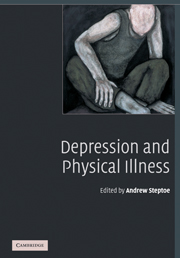Book contents
- Frontmatter
- Contents
- List of contributors
- Preface
- Part 1 Introduction to depression and its determinants
- Part 2 Depression and specific health problems
- Part 3 Biological and behavioural processes
- 12 Inflammation, sickness behaviour and depression
- 13 The hypothalamic–pituitary–adrenal axis: cortisol, DHEA and mental and behavioural function
- 14 Depression and immunity: biological and behavioural mechanisms
- 15 Smoking and depression
- 16 Depression and physical activity
- 17 Depression and adherence to medical advice
- Part 4 Conclusions
- Index
- References
16 - Depression and physical activity
from Part 3 - Biological and behavioural processes
Published online by Cambridge University Press: 17 September 2009
- Frontmatter
- Contents
- List of contributors
- Preface
- Part 1 Introduction to depression and its determinants
- Part 2 Depression and specific health problems
- Part 3 Biological and behavioural processes
- 12 Inflammation, sickness behaviour and depression
- 13 The hypothalamic–pituitary–adrenal axis: cortisol, DHEA and mental and behavioural function
- 14 Depression and immunity: biological and behavioural mechanisms
- 15 Smoking and depression
- 16 Depression and physical activity
- 17 Depression and adherence to medical advice
- Part 4 Conclusions
- Index
- References
Summary
Introduction
There is an extensive scientific literature dating back several decades linking lack of physical exercise with depressed mood, limited coping skills and low levels of psychological well-being [1, 2]. Physical inactivity is also associated with increased risk for many of the medical problems discussed in this book. In some illnesses, such as coronary heart disease (CHD), physical inactivity is thought to have a causal role in disease risk, mediated through metabolic and other pathways [3]. In other conditions, such as chronic pain, inactivity does not cause the problem but nevertheless it contributes to disability. Physical exercise is also important in the regulation and management of chronic conditions, such as diabetes. The question therefore arises of whether the associations between depression and medical problems are mediated through low levels of physical activity and increased sedentary behaviour. Such possibilities have important implications for prevention and patient care.
This chapter discusses the evidence linking physical activity, depression and medical problems and addresses two general questions: First, is reduced physical activity responsible in part for associations between depression and the medical conditions and disabilities discussed in this book? Second, can increases in physical exercise improve the mood of patients and, therefore, be used in the management of these medical problems? The chapter begins with a discussion of the associations between physical activity, depression and depressed mood in clinical and population studies.
Keywords
- Type
- Chapter
- Information
- Depression and Physical Illness , pp. 348 - 368Publisher: Cambridge University PressPrint publication year: 2006
References
- 11
- Cited by



